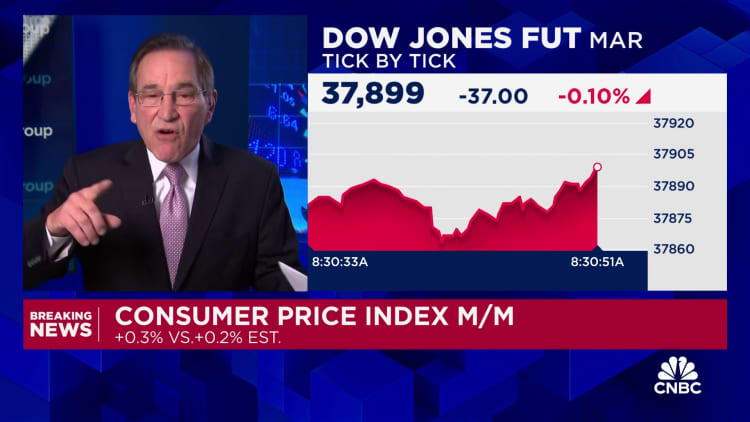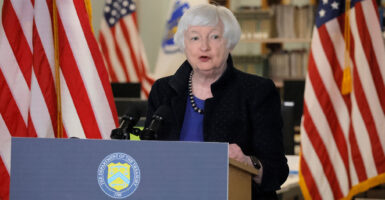UPDATED THU, JAN 11 20242:07 PM EST
Stocks dip after hotter-than-expected inflation report: Live updates

Illustration: Brendan Lynch/Axios
Score one for those who warned inflation would be hard to conquer. December's inflation report shows why that might be the case.
Why it matters: The nation is past the crisis inflation era seen in recent years. But prices in key areas of the economy are still rising more quickly than consumers — and policymakers — would like.
- Sticky inflation, if sustained, could complicate expectations of near-term interest rate cuts — and White House officials' hopes of a brighter inflation landscape in the run-up to the 2024 election.
Driving the news: The Consumer Price Index rose 0.3% last month, the government reported Thursday, compared to November's 0.1% increase.
- In the 12 months through December, the index is up 3.4%, compared to the 3.1% increase in November.
- Core inflation, which excludes food and energy costs, rose 0.3% — the same as the prior month. It's up 3.9% in the year through December, compared to 4% in November.
Between the lines: By one gauge, core inflation looks to be stuck. That measure rose at a 3.3% annualized pace over the past three months, little changed from 3.4% in November and well above the 2% inflation the Fed aims for.
- (Worth noting: The Fed targets a different inflation measure due later this month.)
What they're saying: "These are not bad numbers, but they do show that disinflation progress is still slow and unlikely to be a straight line down to 2%," Seema Shah, chief global strategist at Principal Asset Management, wrote in a note.
Details: The services sector is key to elevated price pressures, even as the prices of many goods are falling. The biggest contributor is shelter costs — which was the largest factor in December's monthly CPI increase.
- Price for shelter rose at a slightly quicker pace (up 0.5%) than in November. Economists have been looking for a cooling based on private-sector data on rents, but the report shows that prices remain firm for now.
- Other sectors within services — including medical care and auto insurance — saw prices rise more quickly.
The intrigue: "The evolution of the data illustrates just how difficult the last mile of efforts to restore price stability will be," RSM chief economist Joe Brusuelas wrote Thursday morning.
- The latest numbers support the cautious approach to rate cuts seemingly embraced by most Fed officials themselves — as opposed to the quicker pace markets have priced in.
- New York Fed president John Williams said in a speech Wednesday afternoon that rate cuts will only be in play once the central bank is sure inflation is cooling.
- "[I]t will only be appropriate to dial back the degree of policy restraint when we are confident that inflation is moving toward 2 percent on a sustained basis," Williams said.
- "With all the key data now in hand, it's hard to see how the January FOMC meeting would result in guidance to ease at the subsequent meeting in March (as markets apparently still expect)."
Also in the news
++++++++++++++++++++++++++++++++++++++++++++++++++++++++++++++++++++++++++
++++++++++++++++++++++++++++++++++++++++++++++++++++++++++++++++++++++++++
- The consumer price index increased 0.3% in December and 3.4% from a year ago, compared with respective estimates of 0.2% and 3.2%
- Excluding volatile food and energy prices, the so-called core CPI also rose 0.3% for the month and 3.9% from a year ago, compared with respective estimates of 0.3% and 3.8%.
- Much of the increase came due to rising shelter costs. The category rose 0.5% for the month and accounted for more than half the core CPI increase.
- Wages adjusted for inflation posted a 0.2% gain on the month, while rising a modest 0.8% from a year ago.

The consumer price index increased 0.3% for the month, higher than the 0.2% estimate at a time when most economists and policymakers see inflationary pressures easing.
- On a 12-month basis, the CPI closed 2023 up 3.4%.
- Economists surveyed by Dow Jones had been looking for a year-over-year reading of 3.2%.
Excluding volatile food and energy prices, the so-called core CPI also rose 0.3% for the month and 3.9% from a year ago, compared with respective estimates of 0.3% and 3.8%. The year-over-year core reading was the lowest since May 2021.
Much of the increase came due to rising shelter costs. The category rose 0.5% for the month and accounted for more than half the core CPI increase. On annual basis, shelter costs increased 6.2%, or about two-thirds of the rise in inflation.
Fed officials largely expect shelter costs to decline through the year as renewed leases reflect lower rents.
Stock market futures were negative following the release while Treasury yields held slightly higher.
Food prices increased 0.2% in December, the same as in November. Egg prices surged 8.9% on the month, but were still down 23.8% annually. Energy posted a 0.4% gain after sliding 2.3% in November as gasoline rose 0.2%, but natural gas declined 0.4%. Airline fares increased 1% for the month.
- In other key price indexes, motor vehicle insurance bounced 1.5% higher, medical care accelerated by 0.6% and used vehicle prices, a key contributor in the initial inflation surge, increased another 0.5% after being up 1.6% in November.
- Wages adjusted for inflation posted a 0.2% gain on the month, while rising a modest 0.8% from a year ago, the Bureau of Labor Statistics said in a separate release.
- Fed officials are paying particular attention to services prices as evidence for whether inflation is showing durable signs of getting back to the central bank’s 2% target.
Services less energy increased 0.4% for the month and 5.3% from a year ago.
The inflation readings cover the same month that the Federal Reserve held its key borrowing rate steady for the third straight meeting. Along with that decision, policymakers indicated that they could begin cutting rates this year so long as the inflation data continues to cooperate.
Despite the higher-than-expected inflation readings, futures traders continued to assign a strong possibility that the Fed would start cutting interest rates in March. The CME Group’s FedWatch gauge of futures pricing indicated about a 69% probability of a March reduction, slightly higher than where it stood Wednesday.
However, the probability also reflects a divide between the market and the Fed about the timing and extent of rate cuts in 2024. Markets expect six rate cuts this year; Fed projections point to just three.
“These are not bad numbers, but they do show that disinflation progress is still slow and unlikely to be a straight line down to 2%,” said Seema Shah, chief global strategist at Principal Asset Management. “Certainly, as long as shelter inflation remains stubbornly elevated, the Fed will keep pushing back at the idea of imminent rate cuts.”
In recent days several policymakers have avoided committing to easier monetary policy.
- Other officials, such as Fed Governor Michelle Bowman and Dallas Fed President Lorie Logan, also expressed skepticism and said they wouldn’t hesitate to hike should inflation turn higher.
- Those comments come against a resilient economic backdrop, with unemployment holding below 4% and consumers continuing to spend despite evidence of rising debt loads and contracting savings.
In other economic news Thursday, the Labor Department reported that initial jobless claims were little changed at 202,000, below the Dow Jones estimate for 210,000.








No comments:
Post a Comment